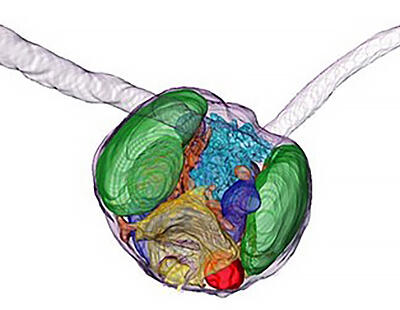A research group comprising Naomi Harada, Director, Research Institute for Global Change, Japan Agency for Marine-Earth Science and Technology, Yuu Hirose, Assistant Professor, Department of Applied Chemistry and Life Science, Toyohashi University of Technology, and Kazuyoshi Murata, Specially Appointed Professor, Division of Structural Biology, National Institute for Physiological Sciences jointly revealed their discovery that the phytoplankton Dicrateria rotunda, a haptophyte collected during a research voyage in the Arctic Ocean, has the ability to synthesize saturated hydrocarbons equivalent to petroleum. The plankton was isolated and cultured, and the hydrocarbon composition was examined. This is the first worldwide report on the discovery of organisms with the ability to synthesize hydrocarbons equivalent to a series of petroleum having 10‒38 carbon atoms. It is expected to facilitate biofuel development. The results were published in the July 19 issue of Scientific Reports, an international journal.
Kerosene, gasoline, diesel oil and other fuels are produced by refining the oil extracted from below the Earth. Crude oil is mainly composed of hydrocarbons (organic compounds) and is thought to be formed as a result of pyrolysis and aging of ancient phytoplankton over many years under high temperature and high pressure conditions (deep inside the Earth). In contrast, hydrocarbons in the crude oil of oil fields in Kamchatka Peninsula, Russia, were very new in age, suggesting that they may have originated as a result of relatively recent microbial and bacterial activities; however, the microorganisms and bacteria in question were not identified.
The number of carbon atoms in oil ranges from 10 to 38. In 2013, the research group went on a research voyage in the Arctic Ocean on the ocean-earth research vessel "Mirai". The purpose was to investigate whether a type of haptophyte (Emiliania huxleyi) inhabiting the Bering Sea has invaded--and is thriving--in the Arctic Ocean, as the ice level in the Arctic Sea has decreased. Phytoplankton groups were collected from August to October in the Chukchi Sea (70° 0'6'N, 168° 44'96'W). Phytoplankton, which can be cultured in isolation, were examined in detail by isolation and cultivation.
It was clarified that the Dicrateria rotunda Arctic Ocean strain (ARC1) synthesizes a series of saturated hydrocarbons with 10 to 38 carbon atoms. These compositions were comparable to those of gasoline (carbon number 10-15), diesel oil (carbon number 16-20), and fuel oil (carbon number 21 or more). The genus is also widespread in other oceans such as the Pacific Ocean and the Atlantic Ocean. The compositions of the hydrocarbons produced by 10 species of the same genus in the collection of phytoplankton preserved in Japan and France were investigated.
All 11 species, including Dicrateria rotunda, were found to be equally capable of synthesizing a series of hydrocarbons with 10-38 carbons. It was also found that these strains have the characteristic of synthesizing more saturated hydrocarbons with fewer atoms. In addition, the Arctic Sea strain ARC1 was used to investigate the variations in the amounts of hydrocarbons produced in response to changing conditions, such as temperature, and nitrogen nutrient concentration.
It was found that the cell size decreased, and the total amount of saturated hydrocarbons increased by about five times in the dark (when photosynthesis stopped) as well as under nitrogen depletion conditions. In general, when saturated hydrocarbons are used as energy storage, they are consumed under dark conditions where photosynthesis halts and the intracellular content reduces. However, in Dicrateria rotunda, levels of several saturated hydrocarbons increased in the dark. From this fact, it seems that these hydrocarbons do not function as an energy storage material. Recent studies have reported that in cyanobacteria (photosynthetic bacteria), 15‒19 carbon atom long saturated hydrocarbons increase flexibility by accumulating in the thylakoid membrane and cell membrane of chloroplasts. The Arctic strain ARC1 also appears to prevent the shrinkage of cells and chloroplasts by enhancing flexibility during stress conditions.
The series of saturated hydrocarbons produced by Dicrateria rotunda are comparable to petroleum and are not problematic for use as biofuels. There are some challenges. Although the synthetic volume depends on conditions, it is low at 17‒79 nanograms per milliliter when the plankton is in a well-lit environment and the water temperature is 20°C. It is necessary to enhance the synthetic capacity for practical use. Dr. Harada said, "I would like to consider acquiring funds for social implementation. In the future, how to efficiently enhance the saturated hydrocarbon synthesis ability of Dicrateria rotunda is an issue to investigate. Therefore, I believe that future research should address issues, such as optimization of synthetic conditions, increase in synthetic amount by breeding and genetic modification, identification of saturated hydrocarbon synthetic gene group, and construction of a saturated hydrocarbon production system using heterogeneous organisms."

This article has been translated by JST with permission from The Science News Ltd.(https://sci-news.co.jp/). Unauthorized reproduction of the article and photographs is prohibited.




